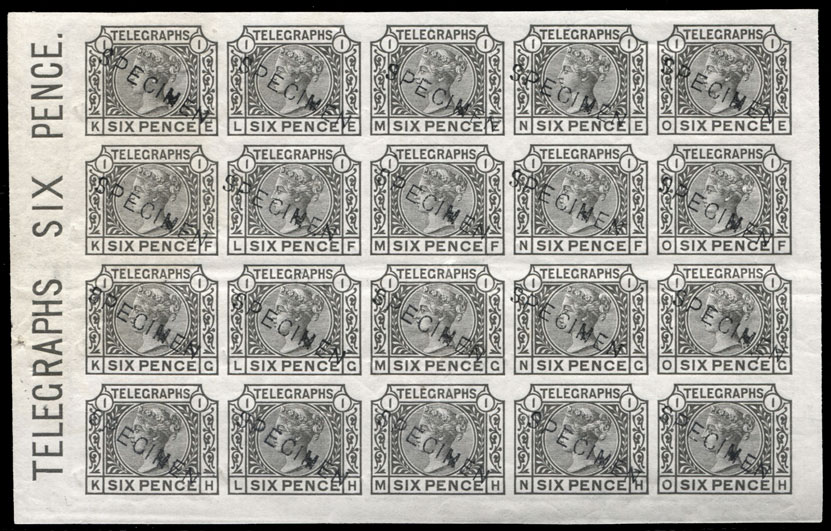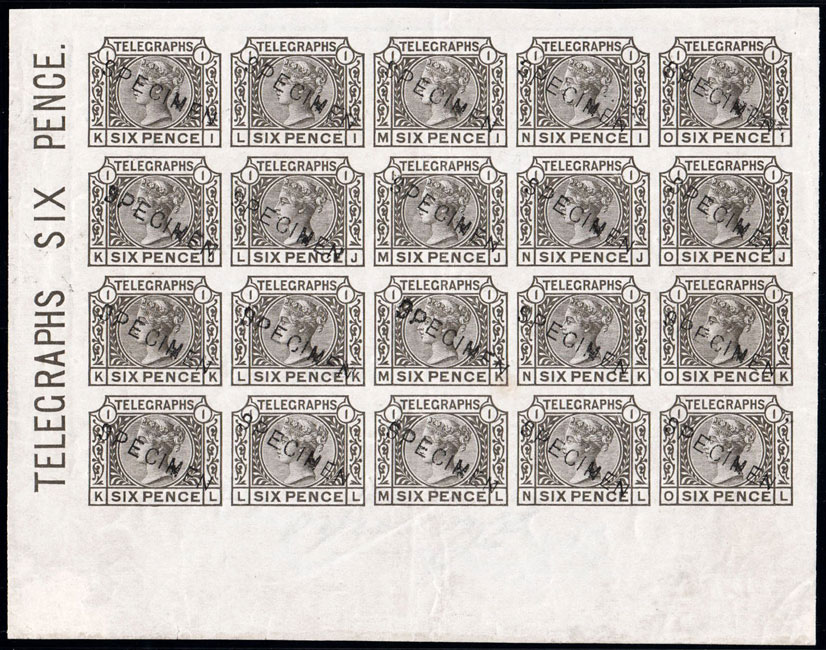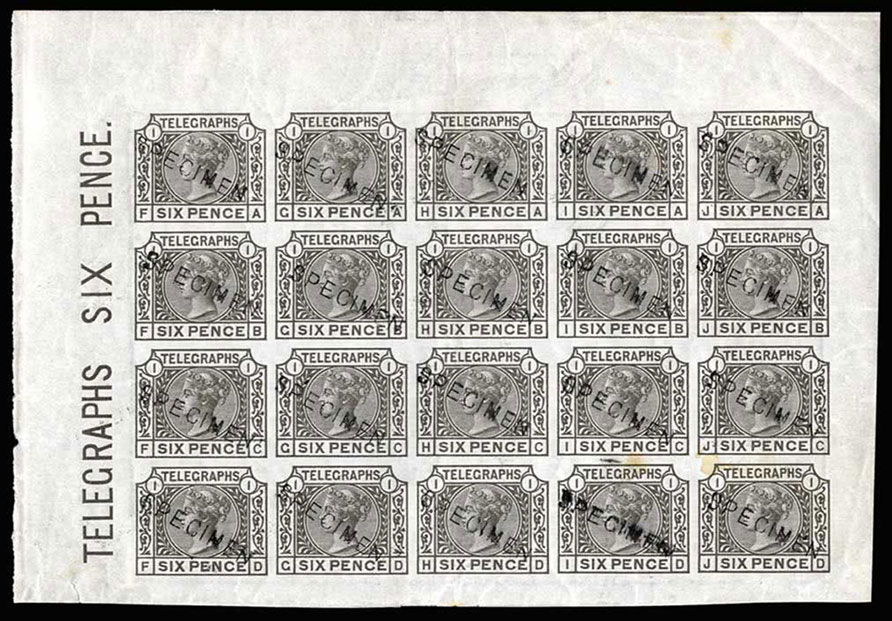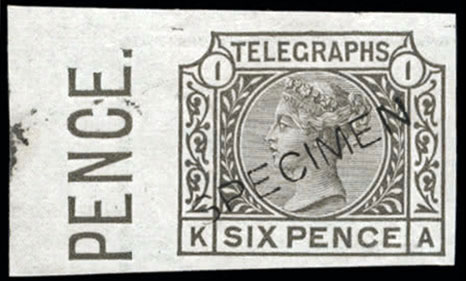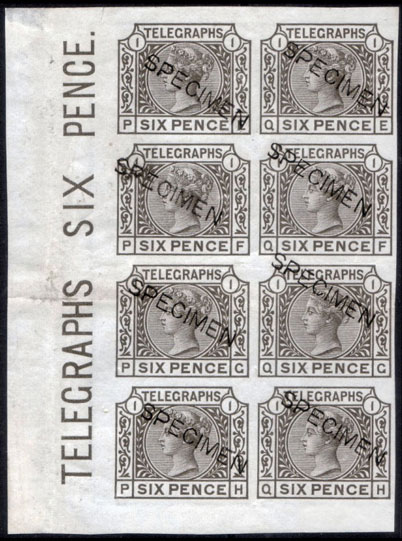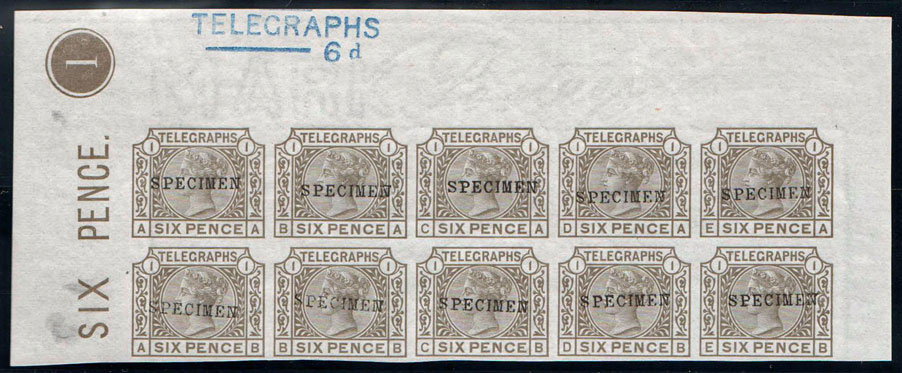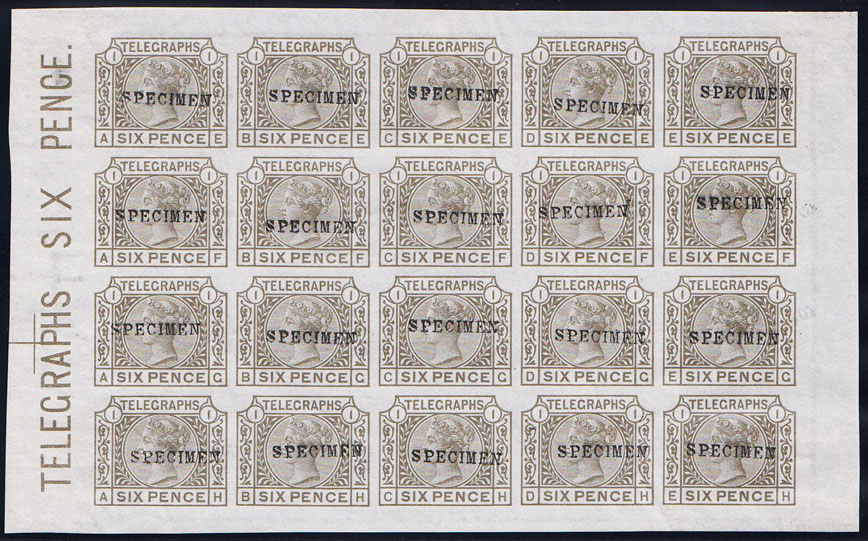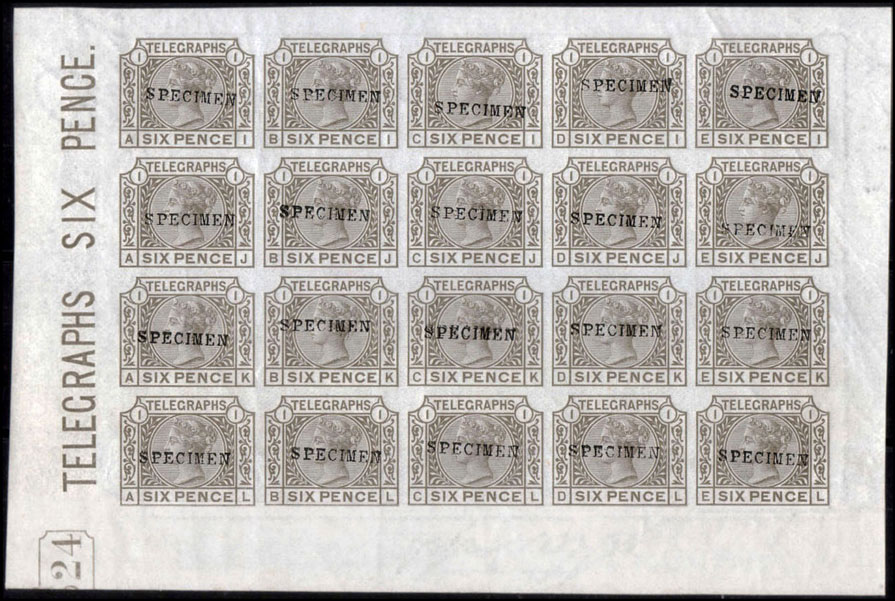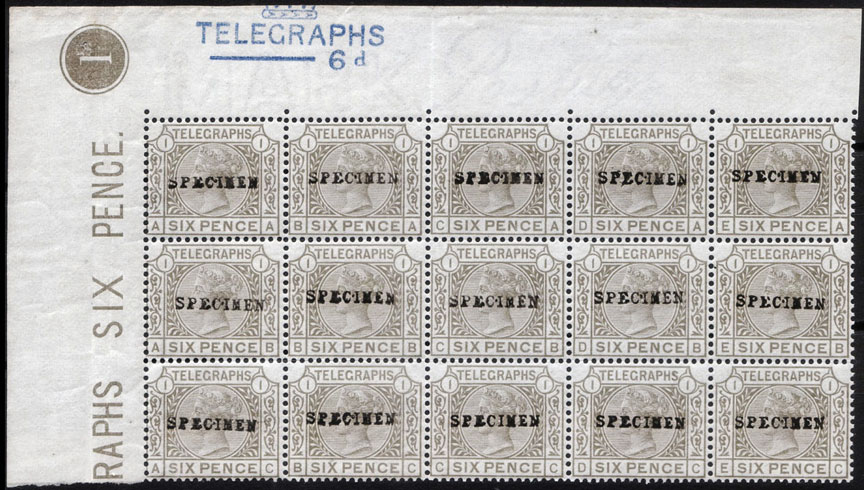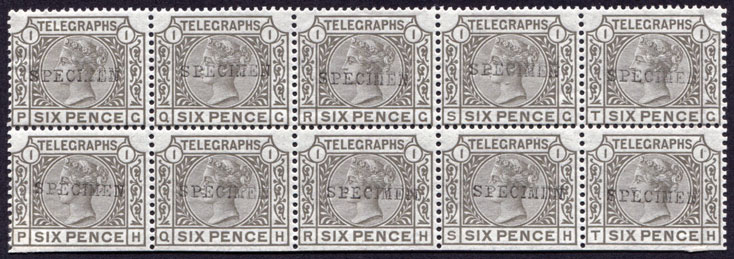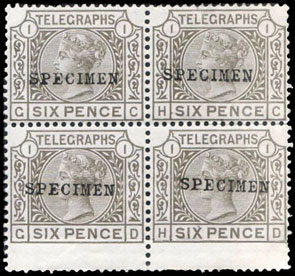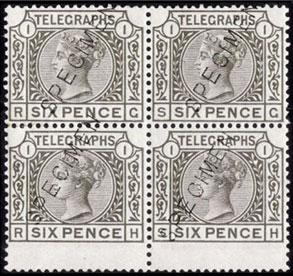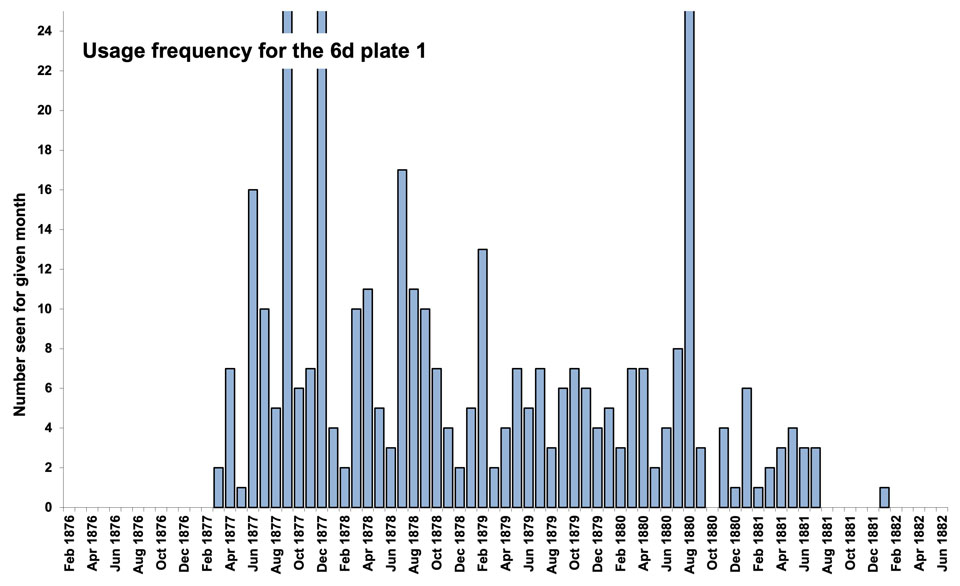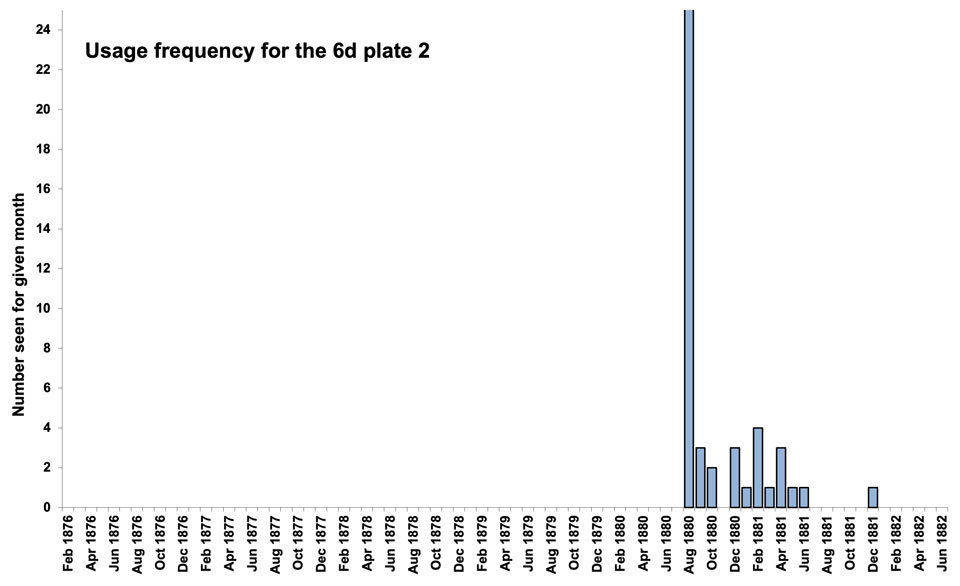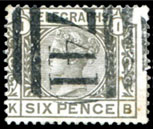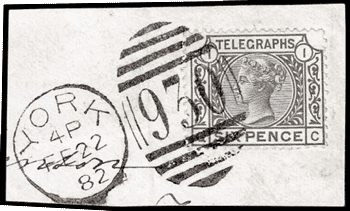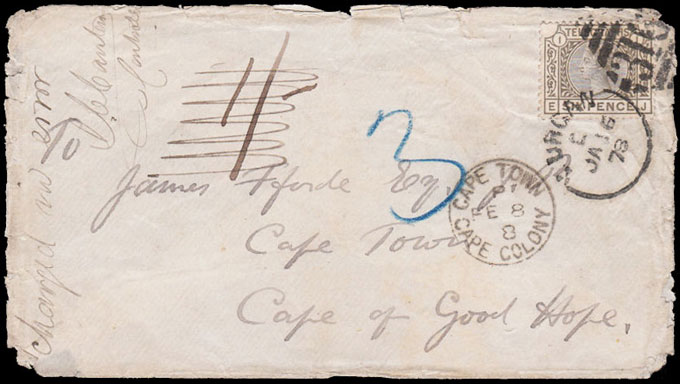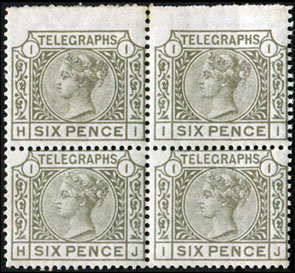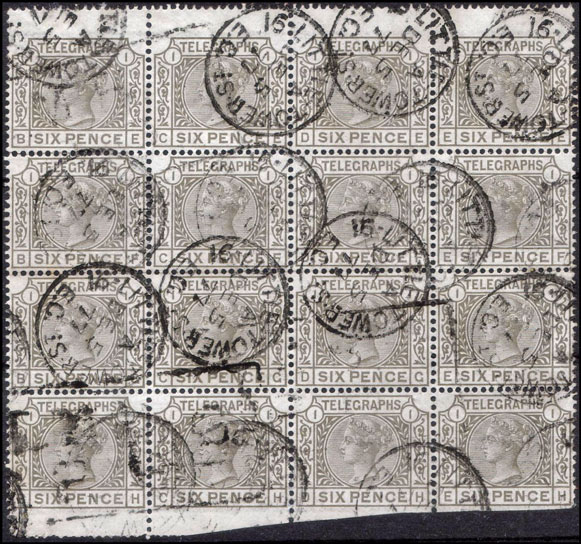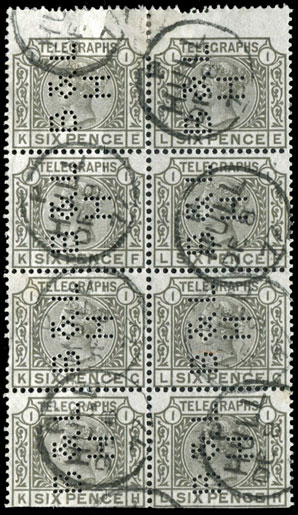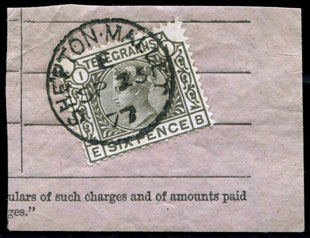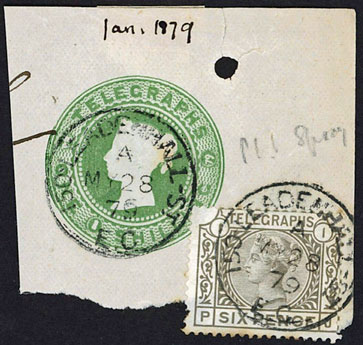1 Essays
2 Die Proofs
3 Sheet Layout
4 Plate Proofs
5 Paper
6 Colour Trials
7 Imprimaturs
8 Colour Standards
9 Specimens
10 Issued Stamps
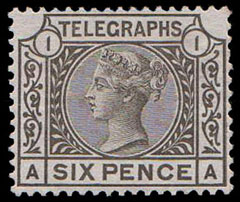
Date: 1 Mar 1877
Plates: 1-2
Printer: De La Rue
Watermark: Spray (sideways)
Perforation: 14
Soon after the first issue of telegraph stamps on 1 Feb 1876 there was a demand for more values. On 24 Mar 1876 the Postmaster General approved six new values: 4d, 6d, 3s, 10s, £1, and £5.
It had been decided that telegraph stamps of the same value as postage stamps would be printed in the same colour and on the same paper as the corresponding postage stamps, hence this stamp was printed in grey on Spray of Rose paper.
Two plates were prepared and registered, imprimaturs exist from both.
Plate 2 was converted to Crown paper part way through its print run.
Essays
Several essays were prepared by De La Rue for the second issue, including designs lettered ‘C’ to ‘H’ and dated 21 Apr 76. It is believed that essay ‘E’ was for the 6d, but it is now missing. Approved designs of all six values were submitted later but are undated. All of these are now in the Royal Philatelic Collection.
| E | 6d | ? | ? | missing |
| — | 6d | 44 | OO | grey, approved design |
For more details on second issue essays click here.
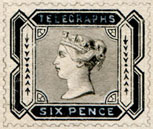
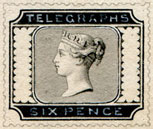
These are from a set of 12 black & white essays which are undated but believed to be circa 1880. Their purpose is not known, but they are likely not related to the issued stamps.
| — | 6d | — | — | black & white |
| — | 6d | — | — | black & white |
For more details on black and white essays click here.
Die Proofs
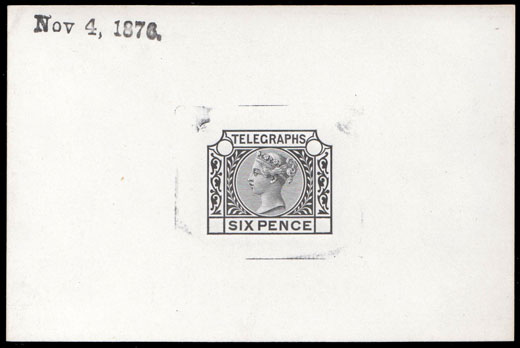
To see more 6d Die Proofs click here.
| Oct 25, 1876 | — | — | Circles in corner letter squares | 1 |
| Oct 26, 1876 | — | — | — | 5 + 1 |
| Oct 27, 1876 | — | — | — | 1 |
| Oct 30, 1876 | — | — | Circles removed | 0 + 1 |
| Oct 31, 1876 | — | — | — | 4 + 1 |
| Nov 2, 1876 | — | — | — | 1 |
| Nov 3, 1876 | — | — | — | 4 |
| Nov 4, 1876 | — | — | — | 4 |
| Nov 6, 1876 | — | — | — | 12 + 1 |
| Nov 7, 1876 | — | — | — | 5 + 1 |
| Nov 9, 1876 | — | — | “BEFORE HARDENING”, flowers open | 9 + 1 |
| Nov 20, 1876 | — | — | “After Striking”, “FJ” | 2 |
| no date | — | — | Basic Die Proof, flowers closed | 1 + 1 |
| no date | — | — | Basic Die Proof, flowers open | 0 + 1 |
| May 12, 1877 | 2 | — | “After Striking”, “HA” | 2 |
From the Striking Books
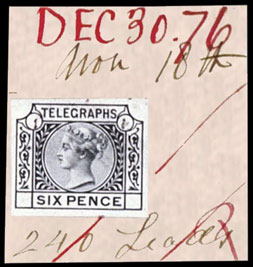
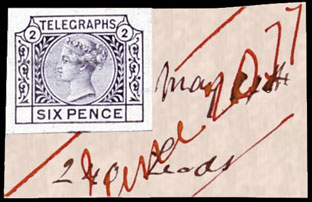
| Nov 18, 1876 | 1* | — | “Nov 18 / 240 Leads”, “Dec 30.76 / P” | 0 + 1† |
| May 11, 1877 | 2 | — | “May 11 / 240 Leads”, “June 20.77” | 0 + 1† |
* Plate number “1” in manuscript.
† Langmead Collection — reconstruction.
In a Countersunk Frame
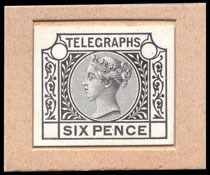
| no date | — | — | Cut down, set in a countersunk frame | 2* |
* Other values have both cream and buff frames. A cream frame may exist, but has not been seen by us.
Sheet Layout
The sheet had 240 stamps in 12 panes, arranged as three rows of four. Each pane had 20 stamps in four rows of five. To the left of each pane reading upwards was “TELEGRAPHS SIX PENCE.”. Plate numbers were in the upper left and lower right corners, current numbers in the lower left and upper right corners, all reading upwards. At the middle of each side was a cross used as a perforating guide.
A Post Office sheet was two horizontal panes, valued at one pound.
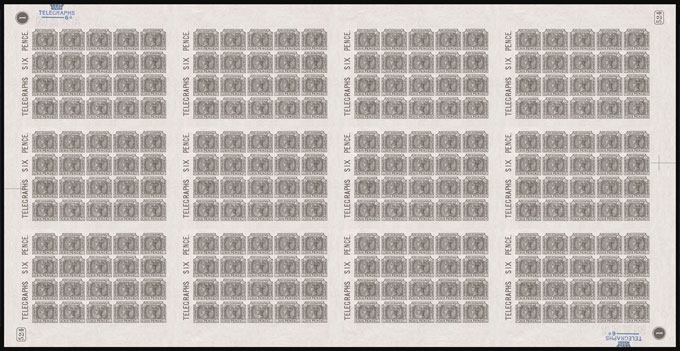
Computer generated image, click to enlarge.
Plate Proofs
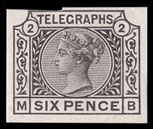
Plate proofs are listed for plates 1 and 2; however, we have not seen an example from plate 1 and given the colour of this stamp, it is easy to confuse plate proofs with imprimaturs. Until proven otherwise, we consider that plate proofs are only known for plate 2. The reconstruction shows there was a block of six.
Red represents an institutionalised example.
Green a known example in private hands.
Blue is unknown but predicted by the pattern.
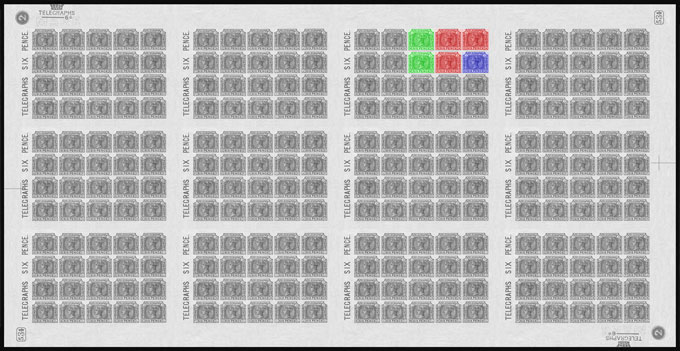
One pair is intact in the Royal Philatelic Collection: NA-OA.
NB is in the Langmead Collection and is illustrated in Wright and Creeke.
Paper
The 6d telegraph stamp was printed on the same paper as the corresponding postage stamp. It was printed on Spray of Rose paper.
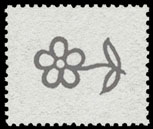
The watermark as seen from the front of the stamp.
For more details on Spray paper click here.
Colour Trials
For the second issue, colour trials were taken for all six values. They were dated “15 DEC 76”. The 6d was to be in the same colour as the corresponding postage stamp so only one sheet was submitted. The trials are usually described as slightly deeper than the issued colour.
Five types of Specimen overprint are all from the same sheet:
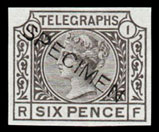
Type 8 diag down
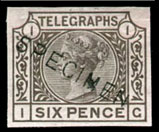
Type 11 diag down
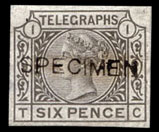
Type 8 horizontal
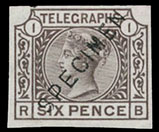
Type 11 diag up
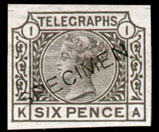
Type 8 diag up
Most examples are Type 11. There are three panes with Type 8 diagonal. It is likely that all stamps from these panes were treated the same way. There are just two examples of Type 8 horizontal known to us: TC and TD.
| Type 8: | Diag Down | Horizontal | Diag Up |
| Type 11: | Diag Down | Horizontal | Diag Up |
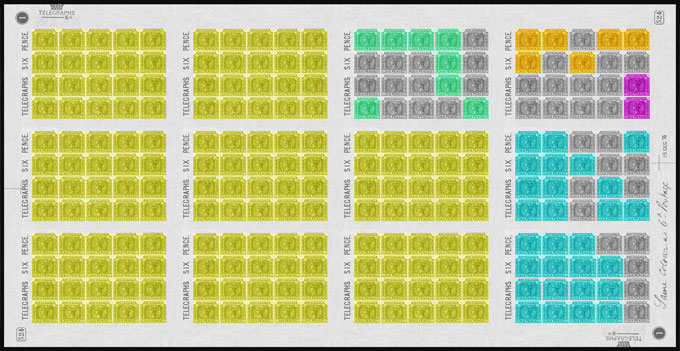
Red represents an institutionalised example.
Green a known example in private hands.
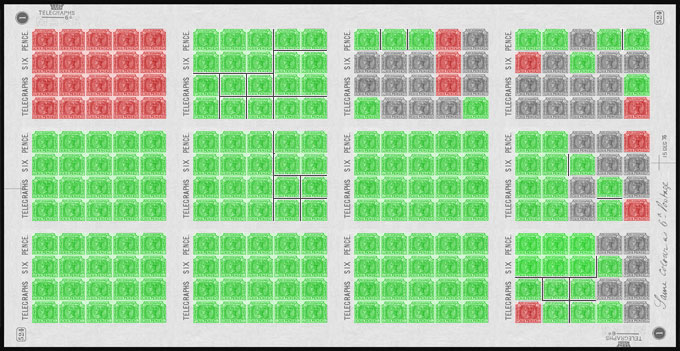
Pane AA-ED, strip NA-NC, and singles PB, PL, TD, are in the Langmead Collection.
NA-NC was noted by Marcus Samuel as the only colour trial with Specimen “blacked out”.
TE (with “DEC 76”) is in the Phillips Collection.
TH (with “6d P…”) is in the Royal Philatelic Collection.
The right margin has manuscript “Same colour as 6d Postage” and datestamp “15 DEC 76”.

Reconstruction.
Click the images to enlarge.
To see a full sheet reconstruction click here.
Imprimaturs
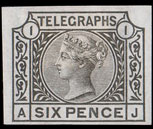
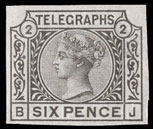
Plates 1 and 2 were registered on 12 Jan 1877 and 18 June 1877.
The registration sheets for the Telegraphs have been lost. However, we can reconstruct them from known examples and a clear pattern emerges. Most have a column of 12 taken, plus four from the adjacent column, and a plate number example from the opposite corner. One sheet of each value has an extra column of 12 taken.
Plate 1 AG is listed as AC in Langmead and Huggins (Tapling Collection).
Red represents an institutionalised example.
Green a known example in private hands.
Blue is unknown but predicted by the pattern.
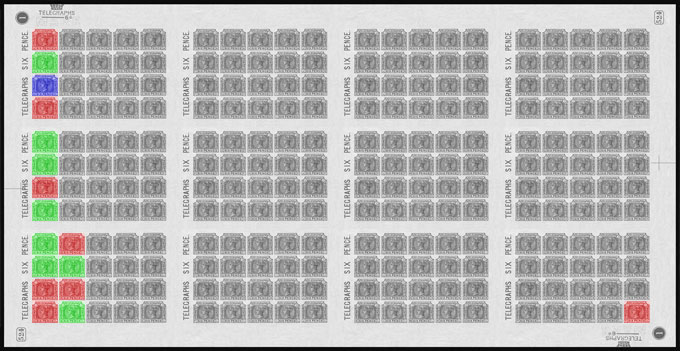
| Institutionalised/Total: | 8/17 |
| Royal Philatelic Collection: | AA, TL |
| British Postal Museum: | BI, BK |
| Tapling Collection: | AG |
| Langmead Collection: | AL |
| Phillips Collection: | AD, AK |
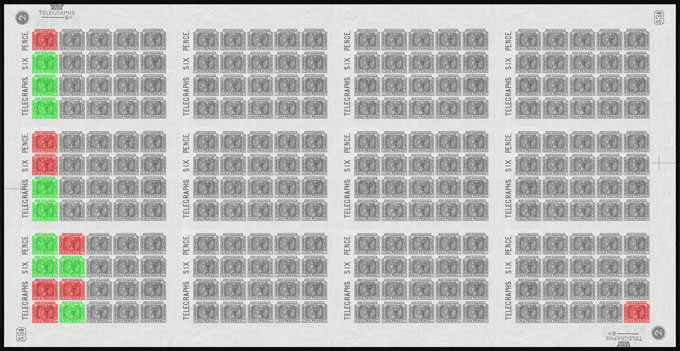
| Institutionalised/Total: | 8/17 |
| Royal Philatelic Collection: | AA, TL |
| British Postal Museum: | BI, BK |
| Tapling Collection: | AE |
| Langmead Collection: | AL |
| Phillips Collection: | AF, AK |
Colour Standards
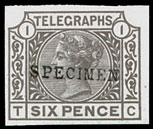
One complete sheet came on to the market in the 1930s: plate 1, imperforate, overprinted Specimen Type 9 horizontally. The stamps are mostly in blocks and scarce as singles.
Red represents an institutionalised example.
Green a known example in private hands.
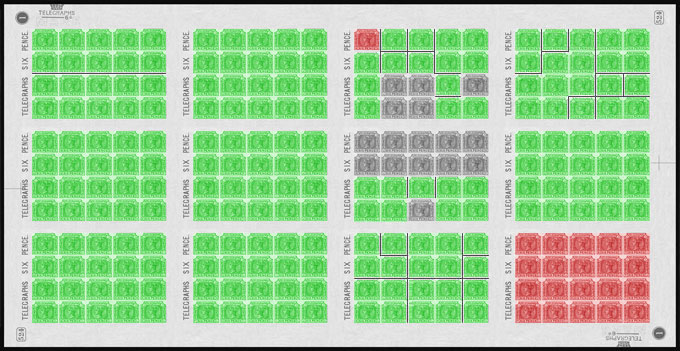
KA and pane PI-TL are in the Langmead Collection.
Pane KI-OL has recently been split.
Click the images to enlarge.
Specimens
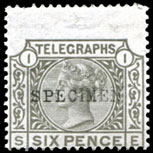
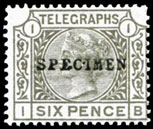
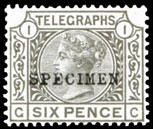
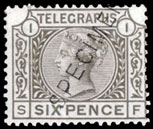
Plate 1 Type 9: scarce, from 3 PO sheets (KE-TH x3), strip of 3, blocks of 4 (x2) and 10 known.
Plate 1 Type 9b: common, from 7 PO sheets (AA-JD x7), plate number pair and blocks of 5, 8, 15 (x2), 20, and PO sheet of 40 known, non plate number blocks of 4 (x7), 16 and 20 known.
Plate 1 Type 9c: common, from 3 PO sheets (AA-JD x2, KE-TH), 2 pairs, blocks of 4 (x3) and 15 known.
Plate 1 Type 11: common, from 4 PO sheets (KE-TH x4), 2 pairs, strip of 3, blocks of 4 (x3) and 16 known.
Click the images to enlarge.
Reference to scarcity, blocks and the number of sheets or panes so treated is derived from reconstructions of known examples within our database.
Issued Stamps
Stamps were issued from plates 1 and 2. Plate 2 was converted to Crown paper part way through its print run.
The usage frequency graphs show that plate 1 was used across the whole period of the second issue with plate 2 overlapping from Aug 1880.
Click the graphs to enlarge.
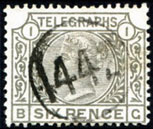
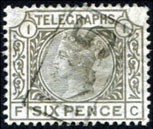
Issued Stamps — Plate 1
Plate 1 (current no. 524) was registered on 12 Jan 1877 and put to press on 15 Jan 1877. It was taken from press on 22 Apr 1880 after printing 35,000 sheets.
Scarcity #10 in mint telegraphs, #7 in used telegraphs.
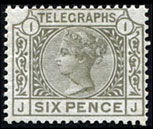
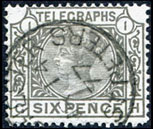
Mint multiples are rare with one block of four known to us. A pair did exist but has since been split.
Used multiples are common with eight pairs and blocks of 4 (x5), 6, 7, 8 (x2), 10 and 16 in our database. The earliest known used example is 14 Mar 1877 at Manchester St Peters (illustrated).
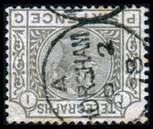
Inverted watermarks are rare. Only one mint and one used single are known to us.
Click the images to enlarge.
Issued Stamps — Plate 2
Plate 2 (current no. 534) was registered on 18 June 1877 and put to press on 22 June 1877. It was re-registered on Crown paper after printing 5,000 sheets on Spray.
Scarcity #31 in mint telegraphs, #31 in used telegraphs.
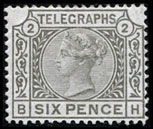
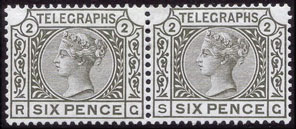
BH is on Spray but has had the wing margin re-perforated along the bottom.
Mint multiples are rare. One pair is in our database.
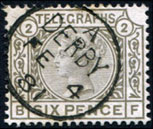
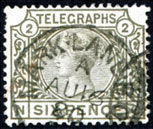
No used multiples are known to us. The earliest known used example is 16 Aug 1880 at Mark Lane B.O. (illustrated). Earlier should exist. About 80% of the used copies are dated 16 or 18 Aug 1880.
No inverted watermarks are known to us.
